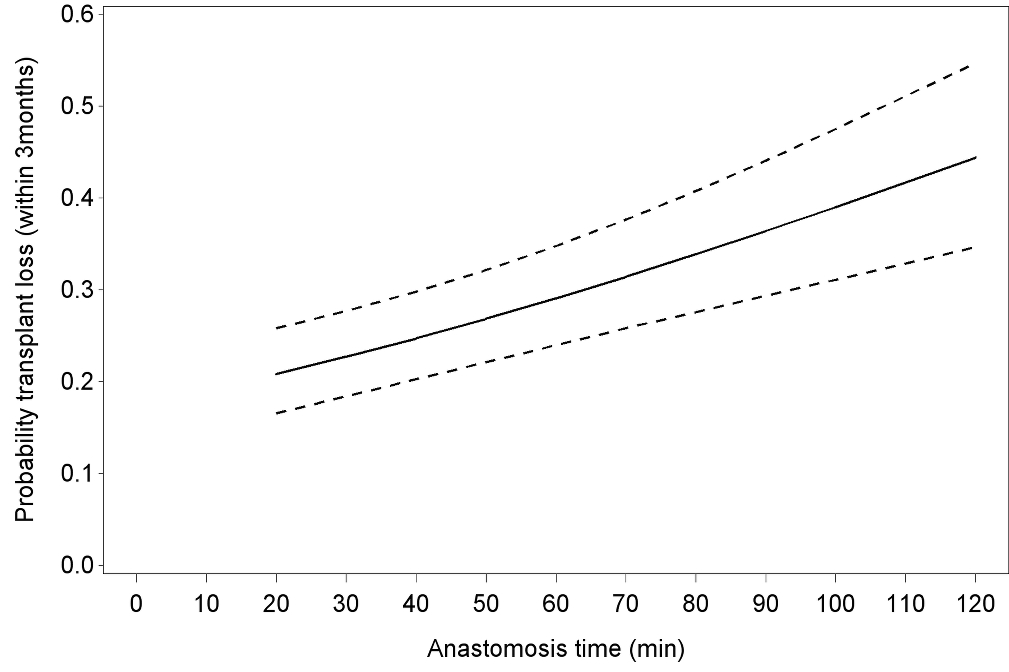Anastomosis Time During Liver Transplantation Impairs Transplant Survival.
1Abdominal Transplantation, UZLeuven, Leuven, Belgium
2ICBSB, KULeuven, Leuven, Belgium
3Eurotransplant, Leiden, Netherlands
Meeting: 2017 American Transplant Congress
Abstract number: C191
Keywords: Multivariate analysis
Session Information
Session Name: Poster Session C: Organ Allocation, Meld Score, Organ Utilization, and Transplant Outcomes
Session Type: Poster Session
Date: Monday, May 1, 2017
Session Time: 6:00pm-7:00pm
 Presentation Time: 6:00pm-7:00pm
Presentation Time: 6:00pm-7:00pm
Location: Hall D1
Warm ischemia sustained during implantation might harm the liver graft.
We investigated the relationship between anastomosis time (AT) and transplant survival in 5223 recipients of deceased-donor livers transplanted in Eurotransplant between 2004-2013. Cox regression analyses were corrected for donor, preservation, recipient variables. Transplant center was included as a random effect as it impacted outcome. AT lasted from graft leaving ice until portal reperfusion. Transplant survival represents all-cause graft failure.
Median follow-up was 4.5y (IQR 2.4-6.8). Median AT was 41min (IQR 43-51). AT independently associated with transplant loss (adjusted hazard ratio 1.04 for every 10min increase, 95%CI 1.01-1.07; p=0.007). Other independent risk factors were donor/recipient age, donor terminal sodium, donation after circulatory death (DCD), split liver, cold ischemia time, lab MELD, acute liver failure, retransplant, and year of transplant. The magnitude of the AT-effect was comparable to the effect of each hour of additional cold ischemia time (adjusted hazard ratio 1.03, 95%CI 1.02-1.05; p<0.0001). The AT-effect was most pronounced early post-transplant when the effect was allowed to differ between <3mo, 3-6mo, 6-12mo, >12mo in the multivariable model. The form of the relation between AT and risk did not suggest a clear cut-off after which the risk for transplant loss increases exponentially. Fig.1 depicts the probability for transplant loss within 3mo in this cohort as a function of AT. The increased risk for transplant loss in DCDs could be attributed to donor warm ischemia time. There was no evidence that DCD livers are more susceptible to AT (no interaction between AT and DCD status), but there were only 208 DCDs in this cohort.
AT associates with inferior liver transplant outcome. The detrimental effect is most pronounced early post-transplant. Minimizing warm ischemia during implantation by reducing AT or keeping the graft cold might improve outcome.
Fig.1: probability for transplant loss within 3mo as a function of liver AT, derived from univariable logistic regression model with random center effect.
CITATION INFORMATION: Jochmans I, Fieuws S, Tieken I, Samuel U, Pirenne J. Anastomosis Time During Liver Transplantation Impairs Transplant Survival. Am J Transplant. 2017;17 (suppl 3).
To cite this abstract in AMA style:
Jochmans I, Fieuws S, Tieken I, Samuel U, Pirenne J. Anastomosis Time During Liver Transplantation Impairs Transplant Survival. [abstract]. Am J Transplant. 2017; 17 (suppl 3). https://atcmeetingabstracts.com/abstract/anastomosis-time-during-liver-transplantation-impairs-transplant-survival/. Accessed December 24, 2025.« Back to 2017 American Transplant Congress
